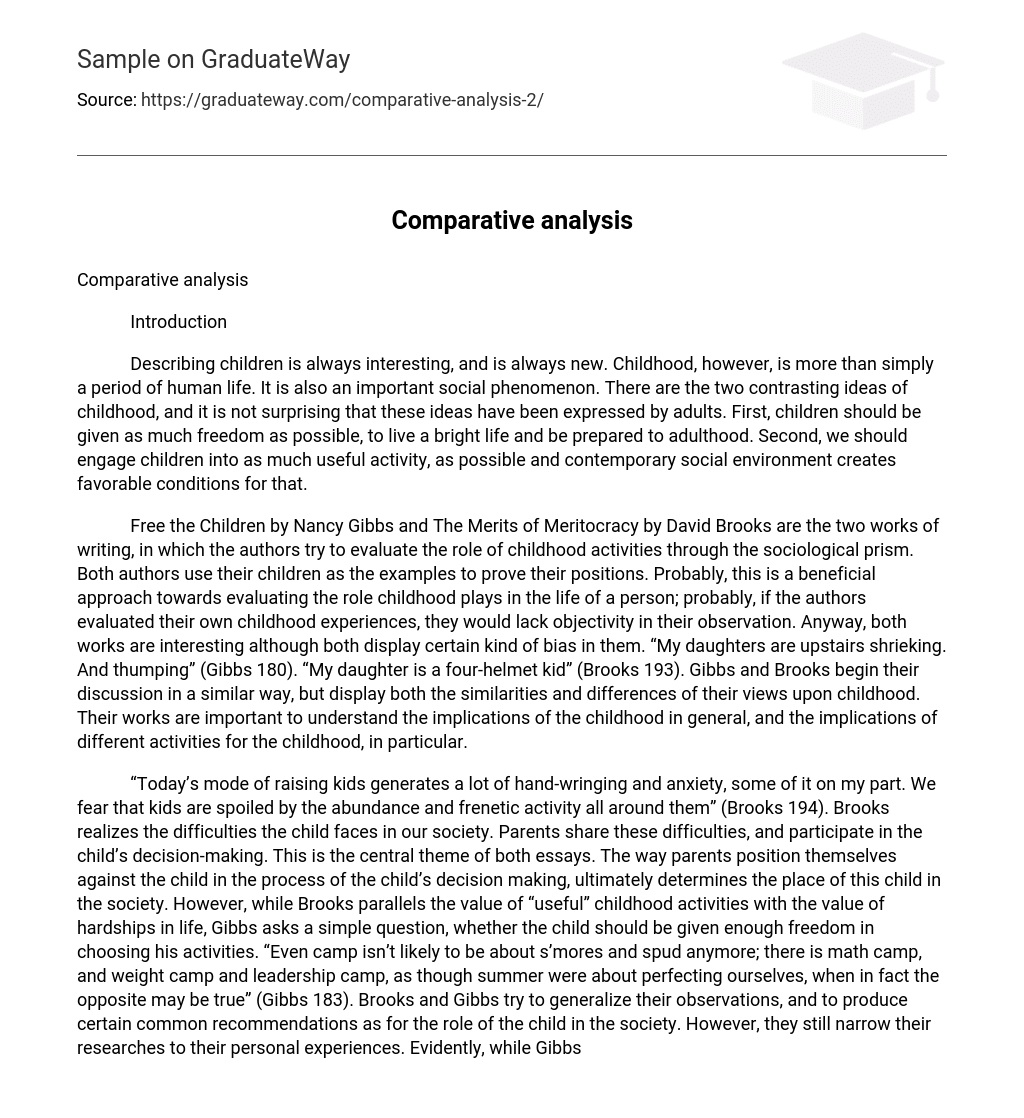Introduction.
Describing children is always interesting and new. However, childhood is more than just a period of human life; it is also an important social phenomenon. There are two contrasting ideas about childhood, which have been expressed by adults. The first idea suggests that children should be given as much freedom as possible to live a bright life and prepare for adulthood. The second idea proposes that we should engage children in as many useful activities as possible, taking advantage of the favorable conditions created by contemporary social environments.
Free the Children by Nancy Gibbs and The Merits of Meritocracy by David Brooks are two works of writing in which the authors evaluate the role of childhood activities through a sociological prism. Both authors use their children as examples to prove their positions, which is a beneficial approach towards evaluating the role childhood plays in a person’s life. If they evaluated their own childhood experiences, they would lack objectivity in their observation. Both works are interesting although they display certain biases.
My daughters are upstairs shrieking and thumping” (Gibbs 180). “My daughter is a four-helmet kid” (Brooks 193). Gibbs and Brooks begin their discussion similarly but display both similarities and differences in their views on childhood. Their works help to understand the implications of childhood in general, as well as the implications of different activities for childhood in particular.
Today’s mode of raising kids generates a lot of hand-wringing and anxiety, some of it on my part. We fear that kids are spoiled by the abundance and frenetic activity all around them (Brooks 194). Brooks acknowledges the challenges children face in our society, and parents share these concerns while participating in their child’s decision-making. This is the central theme of both essays. The way parents position themselves against their child during this process ultimately determines the child’s place in society.
However, while Brooks compares “useful” childhood activities to hardships in life, Gibbs questions whether children should have enough freedom to choose their own activities. “Even camp isn’t likely to be about s’mores and spud anymore; there is math camp, weight camp, and leadership camp as though summer were about perfecting ourselves when in fact the opposite may be true” (Gibbs 183).
Brooks and Gibbs attempt to generalize their observations and provide common recommendations for the role of children in society. However, they still base their research on personal experiences. While Gibbs is concerned with a child’s summer activities, Brooks focuses on how abundance affects a child’s development.
The central aim of both essays is to evaluate traditional approaches towards childhood. Gibbs discusses camps as one means of engaging children in useful activity while Brooks emphasizes extracurricular activities for social development.
However, is this approach truly beneficial for helping a child live a life full of natural experiences? Does not engaging a child into these types of activities necessarily result in negative experiences such as crime or deviance?
When trying to answer this question, the reader is faced with a situation in which both Brooks and Gibbs seem to support their views. Brooks states that society surrounds the individual with a web of instruction, encouragement, and recognition. The hunger for recognition is a great motivator for the meritocrat” (p. 197). Gibbs supports this discussion line and emphasizes the importance of trust in all childhood activities discussed. When Brooks writes that parents spend their weekends driving their children from one activity to another, Gibbs touches on the aspect of trust in parent-child relationships. The problem is that parents do not know whether they will achieve expected results if they use extracurricular activities to protect their child from negative experiences. “Apart from the challenge of trusting our kids, there is also the challenge of trusting ourselves” (Gibbs 186).
Gibbs and Brooks position themselves as parents rather than writers, which is why their views on childhood often align. Despite using different wording and approaches, both essays convey the same message: contemporary children face significant pressures to succeed and be recognized by society. To meet these demands, they must excel in school, adapt to technological changes, and make decisions about everything from cell phone plans to sugar substitutes (Brooks 200). If children are capable of making such decisions, shouldn’t they also be trusted to make good choices during summer vacation? In a world filled with conflicts, pressures, and endless activities, perhaps children should be given moments of unlimited freedom during the summer.
Conclusion.
It is difficult to contrast the two essays, which imply the same ideas and call for similar actions. It would be correct to say that the two analyzed works not only express identical ideas but also supplement each other. The surface differences and contrasts are deceptive as they create a full picture of childhood as a social notion and lead the reader to reconsidering the role and activities of their own children. In their desire to provide the best for their children, Gibbs and Brooks hardly differ from each other. Both writers imply that parents must learn to trust themselves, which will ultimately lead them to trust their children when they want or don’t want freedom of childhood experiences and impressions.
Works Cited.
Brooks, D. argues for The Merits of Meritocracy” in the book edited by R.B. Axelrod, C.R. Cooper, and Alison M.
Warriner (eds.), Reading Critically, Writing Well: A Reader and a Guide, 2005, pp. 193-201.
Gibbs, N. wrote an article titled Free the Children” which was included in a book edited by R.B. Axelrod, C.R. Cooper, and Alison M. Warriner.
Reading Critically, Writing Well: A Reader and a Guide (2005) is a valuable resource for improving both reading and writing skills. The book contains helpful tips and strategies for analyzing texts critically, as well as exercises to practice effective writing techniques. Pages 180-187 offer particularly useful insights on developing clear and concise arguments in writing.





